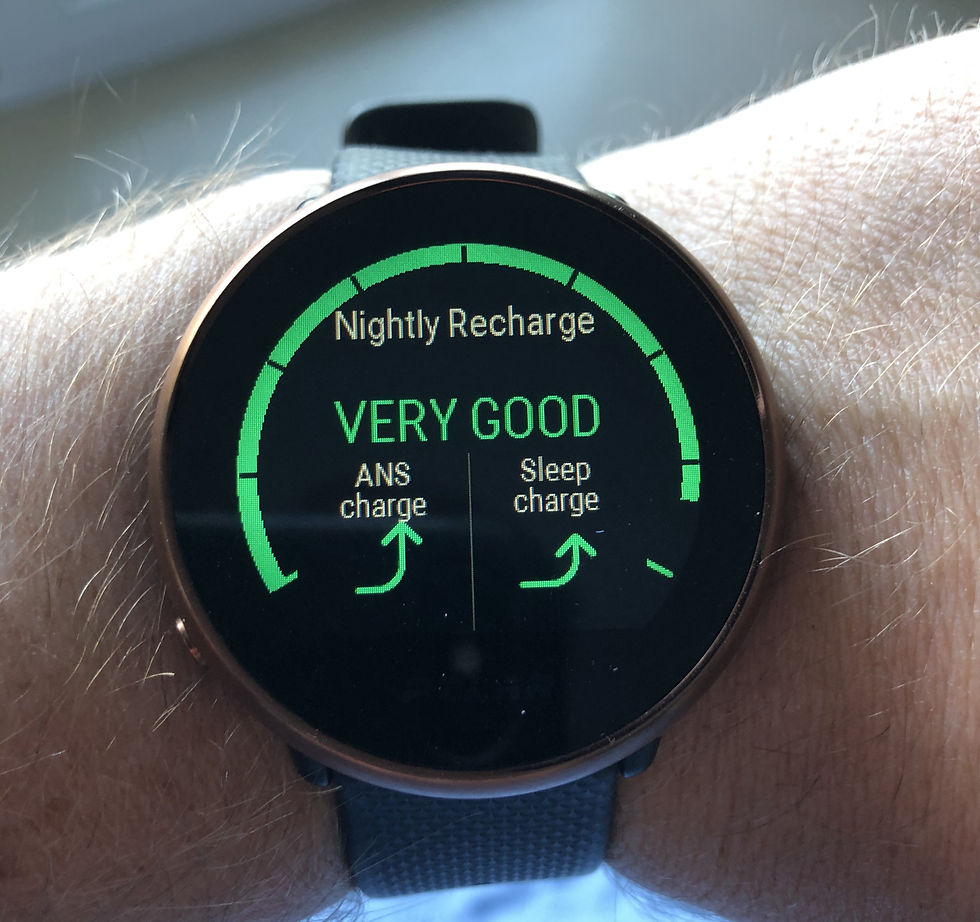I Monitored My Training, Sleep and Stress for 6 Months - This is What I Learned
- Mike Mackey
- Apr 20, 2021
- 7 min read
Updated: Apr 21, 2021
You may have heard this saying before:
“... if you can’t measure it, you can’t manage it.”
People manage their time, their money and their health... Essentially, many people measure just about everything!
But, how do you know if you’re actually making progress?
As health and fitness professionals we tell people to listen to their body, but it’s often much more challenging than we make it out to be.
The use of smart devices to measure body function and activity levels - also known as biofeedback - has never been more readily available than it is today.
Biofeedback is a mind-body technique that involves using visual or auditory cues to monitor and gain control over various involuntary functions, such as breathing rate or heart rate.
It can also be used to help monitor symptoms of various conditions, including high blood pressure, chronic stress, depression and anxiety. Some of the functions that people can learn to control include muscular tension and pain perception.
This might include activating or relaxing certain muscles during movement, or using controlled breathing to slow the heart rate, or reduce feelings of pain or discomfort.
Regarding health and wellness, it can be an amazing tool to use to monitor exercise intensity, unstructured movement and rest/recovery levels.
Despite all of this, it’s mainly used by the general population to measure caloric expenditure… and not much else.
Like most of the world - my fitness routine underwent a major change in 2020.
I went from working 50 hours per week in a gym with an endless amount of equipment and space, to suddenly working and training from my one-bedroom apartment.
I preached to my clients that minimal equipment workouts were just as beneficial as going to the gym - but how could I know this for sure?
If I couldn’t measure it, I couldn’t manage it.
And if I couldn’t manage it, it would be very tough to sell current and prospective clients on its overall effectiveness.
In October, I started using two different Polar Fitness devices - the H10 chest strap heart rate sensor and Ignite smart watch - in an effort to closely monitor my newly founded fitness routine.

I am, in no way, sponsored by Polar Fitness (although that would be pretty deadly).
This isn’t an advertisement for their products - but I still highly recommend them.
Why?
Because their products illustrate a clear picture of what your body does on a day-to-day basis - and what I learned about myself was surprising to say the least.
I thought I knew what my body was telling me.
I didn’t think for a second that I was ‘overdoing it.’
I thought that my sleep quality was sufficient for my age and activity levels.
I thought that I was managing my stress properly.
I discovered the importance of having a weekly plan, mainly because of the relationship the MAC Foundational Four has with one another.
Exercise affects how much you need to eat and drink.
How well you sleep affects the quality of your workout the following day - and in most cases, days.
The ability to manage stress is largely affected by food and water intake.
The relationships are cyclical and absolutely endless.
As a health professional, I always advocate for a balanced lifestyle, but the elements that are easier to measure (exercise and nutritional intake) are profoundly impacted by the ones that aren’t (sleep quality and stress levels)
The real key to long-term success is to see how they interact with each other, and make the necessary adjustments to maximize your performance over time.
After 6 months of self-monitoring, this is what I learned:
It’s WAY Easier to Overtrain Than You Think
‘Overdoing it’ is easy to understand. Overtraining? Not so much.
Most people think of overtraining as a long-term problem.
In some capacity, it is - but not in the way that most people think.
Overtraining isn’t the result of training too hard, for too long - it’s actually the result of doing too much, too soon, after not doing enough, for too long.
The peaks and valleys of training are normal, but they certainly aren’t ideal.
This is why legitimate health and fitness professionals advocate for consistent and sustainable habits before changing too much.
Personally, I challenge clients to achieve 8-12 workouts in their first four weeks so I can closely monitor how their body (and their mind) responds.
In this industry, you will constantly come across people who have gone through fad diets and workout programs, likely with weeks, months or years between consistent active periods.

They expect that it’s reasonable to go from zero to a hundred percent, and wonder why they burn out.
The answer is called 'overreaching' - a noticeable uptick in activity levels, based on what you had been doing in the days and weeks prior.
While it is okay to overreach from time to time, doing it for too long increases your risk for injury or illness, primarily because you aren’t allowing the body to recover in the way that it needs to based on its current ability.
I train for a living, and it’s taken years of consistency to reach a point that I can effectively (and progressively) train 5-6 days per week, balancing strength training and cardiovascular training for myself, and my clients.
If you have been inactive or inconsistent for more than a month, a program that exceeds 3-4 moderate intensity workouts per week isn’t for you.
Period.
Sleep Quality Matters More Than Quantity
I have a ton of friends, colleagues and clients who have young children.
I probably know even more who are shift workers - with first responders and healthcare workers making up the vast majority.

It’s easy for me to say “you should be getting eight hours of sleep every night”, but the unfortunate truth is that it just isn’t realistic for many people.
Instead, I have learned to become an advocate for sleep quality.
I have always struggled with sleep quality, mainly because I seem to toss and turn, and tend to fall asleep on my stomach.
Toying with your sleep position can have a major impact on your sleep quality and in turn, how you feel the following day.
With that, there are some strategies that show promise - even though they may not be the most popular choices!
Eating earlier used to be advice for avoiding weight-gain. Since I don’t really play that game, I’ll advocate for sleep quality instead. Giving yourself 3-4 hours after eating before bed can help big time.
Same with screen time - giving your eyes a break, either through screen brightness settings, blue glasses or pure avoidance can help you fall asleep (and stay asleep) quicker.
Same with alcohol - even just a little bit! I love having a beer (or 5) on the weekends, but monitoring for the last six months has opened my eyes to how little alcohol is required to mess with your sleep.
Full Body Workouts are More Effective
The reasons for this are numerous - time efficiency, strength adaptation, variety. Want to learn more about it? Click here
Most people who split their routine into muscle groups tend to miss out on the desired intensity level, especially if they are doing smaller muscle groups like the shoulders or arms.
So what do they do?
Add cardio at the end of the workout.

Although the intention is good, what this usually does is impact two energy systems - the muscular and cardiorespiratory system. If they follow up that workout with a larger muscle group the following day, their performance is likely to suffer in some way, shape or form.
Grip strength. Dehydration. Range of motion. Fatigue.
There are any number of reasons for a “poor workout,” even if you aren’t fully aware of it.
Doing full body workouts allows adequate intensity, fewer workouts per week and more time to do the other things you love to do.
It also removes the stress to missing a workout, because you don't need to "make up for anything" - you just need to pick up where you left off!
Balance is Key
Since October 16, I have recorded 107 training sessions.
If you quickly do the math, it equates roughly to 16 workouts per month, or doing a workout every second day.
Of those, roughly 75% came from full body strength training - most of them using minimal equipment and my own bodyweight.
The remainder came from a combination of indoor cycling, swimming or walking - usually at a lower intensity (60-70% of my age-predicted heart rate maximum)

It goes without saying that doing a variety of exercise types is essential to developing a well-rounded strength and endurance base.
I’ve learned more and more about the balance between strength and cardio - and the biggest takeaway is that more isn't always better.
High-intensity interval training (HIIT) is very mainstream because of its claims to "burn more calories/fat" - and it just isn't true.
The truth is, lower intensity cardio like walking/biking is much more effective and enjoyable, especially for the general population. I have experienced notable improvements in my physical performance and my mental state in just a few short months.
I anticipate that the next 6-12 months will see a 60-40 split between strength training and LISS (low-intensity steady state) cardiovascular, and I'm very excited to share more about the process.
Listen to Your Heart
Your heart rate may tell you more than you realize - and I don't mean exercise intensity.
Plenty of people have trouble recognizing when they are stressed out, but by monitoring your resting heart rate, you may discover something about yourself that you never knew.

Last year, much like the rest of the world, I went through several stressful situations related to my professional and personal life.
During these times, I noticed that my resting heart rate was 10-20bpm higher than it normally was, even when I was asleep.
It was still within a healthy range - 65bpm versus 45bpm - but still eye opening nonetheless.
I’m happy that I was able to see these changes, because many go years without realizing something may be wrong, and so it goes untreated.
Some even ignore symptoms of tension and stress, but through monitoring things like heart rate and blood pressure, we are better able to understand how our bodies internalize the realities of life.
The reasons for self-monitoring are different depending on the goal, but no matter what you decide to measure, it should always come back to one thing - personal health.
It seems that the world of health and fitness places more emphasis on the “fitness” aspect, and not near enough on "health."
Having abs doesn't make you healthy.
Neither does working out seven days per week.
How you look and how you feel are not mutually exclusive, nor are they completely separate from one another.
We only get one body - we need to take care of it!
Monitor your performance, and let how you look be the by-product.







Comments